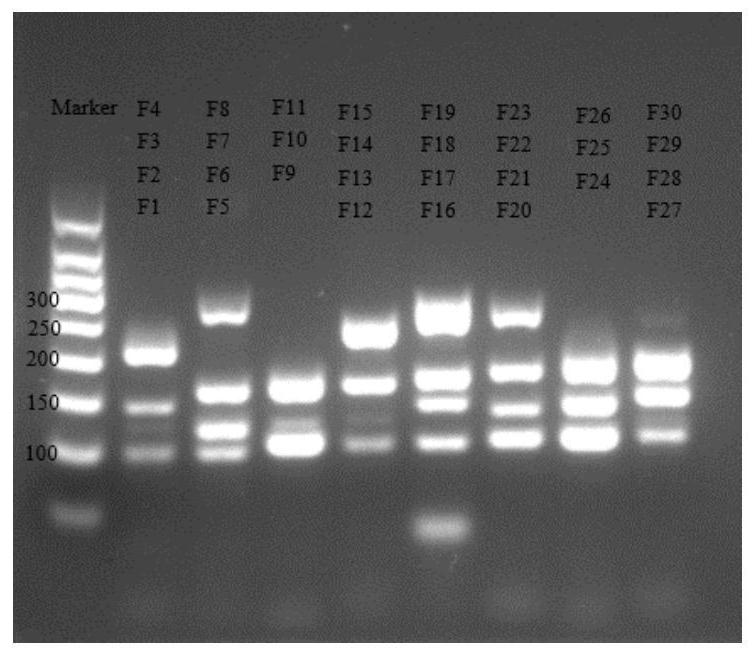SSR primer of endangered species thuja sutchuenensis and application of SSR primer
A technology for planting thuja and endangered species, applied in the field of SSR primers, to achieve the effects of high stability, large amount of useful genetic information, co-dominant inheritance and convenient and rapid detection
- Summary
- Abstract
- Description
- Claims
- Application Information
AI Technical Summary
Problems solved by technology
Method used
Image
Examples
Embodiment 1
[0031] Design and screening of embodiment 1 specific SSR primer
[0032] 1. Find sequences containing microsatellite repeat units
[0033] (1) Acquisition of the original sequence of Thuja thuja: Extract the chloroplast DNA of Thuja thuja, and use HiSeq PE150 mode (double-end sequencing) for de novo sequencing to obtain the original sequence of the chloroplast genome of Thuja japonica.
[0034] (2) Raw data preprocessing: For the raw data obtained by high-throughput sequencing obtained in the above step (1), for the quality coding mark of each base, different software adopts different schemes. The scheme used in this experiment is Phred The qualityscore value ranges from 0 to 62, the corresponding ASCII code is from 64 to 126, and the score is between 0 and 40.
[0035] (3) Raw data quality assessment: use FastQC to assess the quality of the original data, make statistics and visualize some basic information, and determine its data quality.
[0036] (4) Raw data quality cont...
Embodiment 2
[0076] Example 2 Genetic Diversity Analysis of Thuja Population
[0077] Genetic diversity indicators mainly include the number of alleles (Number of alleles, Na), the number of effective alleles (Number of effective alleles, Ne), observed heterozygosity (Observed heterozygosity, Ho), expected heterozygosity (Expected heterozygosity, He ) and inbreeding coefficient (Inbreedingcoefficient, F IS ). The number of alleles refers to the mean value of the number of allele types at all gene loci measured in the population, reflecting the level of genetic diversity of the population. The effective number of alleles is the reciprocal of the homozygous frequency in the population, which is more suitable for comparing the degree of change in the genetic diversity of the population. The observed heterozygosity refers to the ratio of the number of heterozygotes actually observed to the total population, and the expected heterozygosity refers to the theoretically calculated heterozygosity...
Embodiment 3
[0082] Example 3 Analysis of Genetic Structure of Thuja Population
[0083] We used the STRUCTURE (version 2.3.4) software to analyze 10 populations (2 wild populations in Xianyi Township, 1 wild population in Manyue Township, 1 wild population in Baiquan Township, 1 wild population in Guanmian Township, and 1 wild population in Qishu Township). Populations, 1 wild population in Mingzhong Township, 1 artificial population in Xianyi Township, 1 artificial population in Baiquan Township, 1 artificial population in Guanmian Township) were analyzed by Bayesian clustering. Set the K value from 2 to 12, the number of independent operations is 10, use the mixed ancestor model, Burn-in is set to 10000-step, and Markov chain Monte Carlo (MCMC) is set to 100000-step. After finishing the calculation results, upload them to the STRUCTURE HARVERST (version 0.6.94) website to calculate the delta K value and infer the optimal K value. We used the MEGA (version 6.0) software to establish a p...
PUM
 Login to View More
Login to View More Abstract
Description
Claims
Application Information
 Login to View More
Login to View More - R&D
- Intellectual Property
- Life Sciences
- Materials
- Tech Scout
- Unparalleled Data Quality
- Higher Quality Content
- 60% Fewer Hallucinations
Browse by: Latest US Patents, China's latest patents, Technical Efficacy Thesaurus, Application Domain, Technology Topic, Popular Technical Reports.
© 2025 PatSnap. All rights reserved.Legal|Privacy policy|Modern Slavery Act Transparency Statement|Sitemap|About US| Contact US: help@patsnap.com



